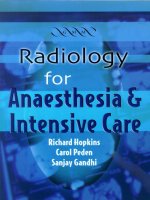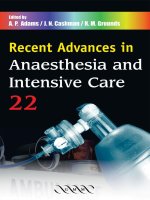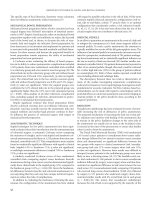Radiology for Anaesthesia and Intensive Care - Part 8 doc
Bạn đang xem bản rút gọn của tài liệu. Xem và tải ngay bản đầy đủ của tài liệu tại đây (898.15 KB, 36 trang )
CT head
5
232
Question 5
72-year-old female.
Past history of poorly controlled hypertension.
Collapsed at home (Fig. 5.15).
What is the diagnosis?
What are the common causes?
Fig. 5.15 Quiz case.
Answer
Intracerebral haematoma
There is a brain stem intracerebral haematoma causing hydrocephalus from
ventricular obstruction at the level of the IV ventricle and aqueduct.
Common causes
Hypertension
external capsule basal ganglia
pons
thalamus (see Fig. 5.16)
cerebellum
Trauma
Aneurysm
Arteriovenous malformation
Chap-05.qxd 09/Oct/02 11:07 AM Page 232
Case illustrations
5
233
Anticoagulation (see Fig. 5.17)
Haemorrhagic infarction (see Fig. 5.18).
Comment
The acute haematoma is normally rounded homogeneous and hyperdense.
With clot retraction, a surrounding rim of low-density oedema appears.
A non-contrast-enhanced CT scan is always performed, if intracerebral
Fig. 5.16 Thalamic haemorrhage.
Fig. 5.17 Frontal haemorrhage.
The patient was anticoagulated
with warfarin.
Chap-05.qxd 09/Oct/02 11:07 AM Page 233
CT head
5
234
haemorrhage is suspected. Otherwise it is not possible to distinguish acute
blood from avid contrast enhancement (e.g. an avidly enhancing tumour).
Mass effect is often negligible and less than a tumour of a similar size.
The haematoma can rupture into the ventriclular system and then cause
hydrocephalus. Over a period of 1–2 weeks, the haematoma decreases in
density starting in the periphery and working centrally. At this stage,
contrast enhancement occurs peripherally due to formation of
hypervascular granulation tissue.
Intracerebral haemorrhage is less common than infarction and a
history of hypertension must be sought. Spontaneous rupture of the
lenticulostriate arteries are frequently the cause and this explains why
the basal ganglia are a common site.
Fig. 5.18 Haemorrhagic infarct in
the left middle cerebral artery
territory. Note how the acute
blood is limited to the middle
cerebral artery territory.
Chap-05.qxd 09/Oct/02 11:07 AM Page 234
Case illustrations
5
235
Question 6
71-year-old male.
Slurred speech and hemiparesis.
Report the CT (Fig. 5.19).
What features of the history and physical examination are important?
What investigations should be performed?
Answer
Infarction of the left middle cerebral artery territory
Assessment for risk factors for cerebrovascular disease are important in
both the physical examination and the further investigations requested.
Physical examination
Hypertension
AF, heart murmurs, carotid bruits
Stigmata of raised cholesterol
Further investigations
ECG
Echocardiogram, carotid Doppler
Blood lipid profile
Fig. 5.19 Quiz case.
Chap-05.qxd 09/Oct/02 11:07 AM Page 235
CT head
5
236
Comment
Cerebral infarction is rarely visible on CT prior to 12 hours, although newer
scanners are improving resolution making earlier diagnosis possible.
Early signs include:
Hyperdense artery (from acute intraluminal thrombus) (see Fig. 5.20).
Loss of grey–white interface.
Fig. 5.20 Cerebral infarction is not
readily identified before 12 hours
duration. This scan demonstrates a
hyperdense middle cerebral artery
due to vessel thrombosis. A later scan
confirmed infarction of the middle
cerebral artery territory. A further
early sign of infarction is loss of
differentiation between
grey and white matter.
Fig. 5.21 Posterior cerebral artery
territory infarction.
Chap-05.qxd 09/Oct/02 11:07 AM Page 236
Case illustrations
5
237
The hallmark of ischaemia is a wedge-shaped low-density areas of affected
brain which reaches the cortical surface. Middle cerebral artery infarction
spares the thalamus. Mass effect is not uncommonly seen in the first week
with sulcal effacement, ventricular and cisternal compression.
It is important to appreciate the territory supplied by the cerebral
arteries as this enables confident diagnosis and helps distinguish infarction
from space-occupying lesions. Space-occupying lesions cross arterial
territories while infarction is limited by them. Infarction in the territory of
the middle cerebral artery (hemiparesis) and the posterior cerebral artery
(see Fig. 5.21) (producing homonymous hemianopia) are the more
commonly affected arteries. The anterior cerebral artery territory is rarely
affected partly due to good collateral supply from the anterior
communicating artery. On CT an area of mature infarction is of reduced
density and appears darker than acute infarction (Fig. 5.22).
Fig. 5.22 Mature infarct in the territory
of the left middle cerebral artery. Mature
infarction is of lower density (darker
black) than acute infarction.
Chap-05.qxd 09/Oct/02 11:07 AM Page 237
CT head
5
238
Question 7
58-year-old female.
Admitted following road traffic accident and minor head injury (Fig. 5.23).
Normal physical examination.
No fracture could be seen on the film and the patient was discharged from
accident and emergency.
What is the radiological abnormality on the plain film of the skull?
Suggest two possible differential diagnoses.
What radiological investigation would you want to request next?
Fig. 5.23 Quiz case.
Answer
Meningioma
No skull fracture is present. There is a 3 cm diameter oval opacity of
calcific density projected over the skull vault. Possibilities would include a
calcified meningioma or possibly a giant calcified aneurysm. A frontal
skull X-ray should be reviewed to confirm that the lesion is within the
skull vault. A CT scan of the brain would be a suitable next request
(see Fig. 5.24).
The CT scan demonstrates a densely calcified lesion arising from the
middle cranial fossa which is extra-axial (outside of the brain). These are
features characteristic of a calcified meningioma.
One of the great advantages of MRI scanning is its multiplanar capability
and coronal imaging clearly confirms the extra-axial nature of the lesion
(see Fig. 5.25).
Chap-05.qxd 09/Oct/02 11:07 AM Page 238
Case illustrations
5
239
Comment
Meningioma is the most common extra-axial intracranial tumour often
found incidentally. Presentation is usually in middle age unless associated
with neurofibromatosis type 2 when it occurs in childhood and can be
multiple. Meningiomas occur at sites where arachnoid villi are in proximity
to the dura such as the venous sinuses.
Fig. 5.24 CT of a densely calcified
meningioma.
Fig. 5.25 MRI of meningioma. The
extra-axial nature of the meningioma
is clearly seen on this coronal MRI
scan. The brain can be seen displaced,
but separate from the tumour.
Chap-05.qxd 09/Oct/02 11:07 AM Page 239
CT head
5
240
Locations:
cerebral hemispheres;
parasagittal;
middle fossa and sphenoid bone;
posterior fossa, cerebellopontine angle, spinal.
Cerebellopontine angle meningiomas may mimic acoustic neuromas.
Hyperostosis with skull vault thickening and sclerosis may be present on
plain films. CT-imaging features are of a well-circumscribed, slow-growing
dense lesion, which may calcify. Enhancement is avid and homogeneous.
The prognosis is generally better compared with gliomas and metastatic
lesions which are both more common.
Chap-05.qxd 09/Oct/02 11:07 AM Page 240
Case illustrations
5
241
Question 8
Fig. 5.26 Quiz case.
55-year-old female.
History – known breast
carcinoma.
Recent headaches.
Possible cerebral metastases
(Fig. 5.26).
What is the abnormality?
What further test is
necessary?
Answer
Cerebral metastasis
There is an area of low density in the region of the left frontal lobe.
This is rather asymmetric when compared with the right side.
Intravenous contrast enhancement should be given in view of the
history of breast carcinoma.
Following IV contrast (Fig. 5.27) there is a 1 cm diameter area of avid
contrast enhancement. This is a cerebral metastasis and the low density
surrounding it is white matter oedema.
Situations requiring IV contrast include:
suspected malignancy primary or secondary,
inflammatory conditions such as abscess,
vascular lesions such as arteriovenous malformations,
venous sinus thrombosis (to demonstrate failure in opacification? and
filling defects in the sinus).
Chap-05.qxd 09/Oct/02 11:07 AM Page 241
CT head
5
242
Fig. 5.27 Breast metastasis
enhancing following IV contrast.
The surrounding low density is
oedema.
Chap-05.qxd 09/Oct/02 11:07 AM Page 242
Case illustrations
5
243
Question 9
49-year-old male.
History – bizarre behaviour for several weeks more rapid deterioration over
past few days.
Describe the abnormal radiological signs (Figs 5.28 and 5.29).
What is the differential diagnosis?
What urgent management should be considered?
Fig. 5.28 Quiz case.
Fig. 5.29 Quiz case.
Chap-05.qxd 09/Oct/02 11:07 AM Page 243
CT head
5
244
Fig. 5.30 Ring-enhancing lesion
post-contrast. This is a further example
of a malignant glioma. The differential
for this lesion includes an abscess
and clinical correlation is necessary
(clinical history, temperature,
inflammatory markers – CRP, leucocyte
count). Abscesses are typically thin
walled with surrounding oedema.
Answer
Malignant brain glioma
There is a ring enhancing lesion in the right frontal lobe which is
surrounded by extensive oedema. The abnormality has marked mass effect
with deviation of the midline to the left side, effacement of the frontal
horn of the right lateral ventricle and basal cisterns is present.
The differential diagnosis for intracerebral ring enhancing lesions includes:
primary brain tumour (glioblastoma multiforme) (see Fig. 5.30),
metastases (see Fig. 5.31),
cerebral lymphoma,
abscess (pyogenic or fungal),
resolving haematoma (which is surrounded by granulation tissue).
Given the history of gradual deterioration pyogenic abscess is unlikely.
Corticosteroids to reduce the oedema can improve symptoms in the short
term. This lesion was biopsied and was found to be a glioblastoma
multiforme.
Chap-05.qxd 09/Oct/02 11:07 AM Page 244
Case illustrations
5
245
Comment
Neurosurgical assessment and sampling of the lesion to exclude pyogenic
abscess should be considered if there are signs of sepsis or an obvious
source of infection. If the clinical picture is that of sepsis, then possible
sources would include frontal sinusitis, mastoiditis or blood-borne infection
from endocarditis. The latter tends to give rise to multiple abscesses.
The possibility of AIDS or altered immunity should be kept in mind with
multiple abscesses as cerebral toxoplasmosis appears very similar to
pyogenic abscess.
Fig. 5.31 Multiple ring-enhancing lesions. This appearance is typical of multiple
cerebral metastases. The presence of a primary lesion helps with the diagnosis.
Chap-05.qxd 09/Oct/02 11:07 AM Page 245
CT head
5
246
Question 10
Answer
Metastasis
There is a soft tissue density mass measuring 4 cm ϫ 2.5 cm in diameter
occupying the paranasal air sinuses particularly on the right side. This is
destroying bone and eroding into the medial wall of the right orbit.
A malignant process is likely.
Comment
The case above was a metastatic deposit from renal cell carcinoma.
It illustrates the need to interrogate the whole film and in particular to
look at certain sites where disease is commonly missed. These review areas
must be checked before the film is reported.
Review areas:
skull base (for malignant disease);
pituitary fossa (tumours);
sinuses;
temporal lobes (low density in herpes simplex encephalitis);
sulci (for isodense subdural or subarachnoid blood);
‘top slice’ (parafalcine meningioma);
cisterns (blood, e.g. SAH);
bone windows for fractures or metastatic disease in the skull vault.
64-year-old male.
Recurrent nose bleeds.
Renal carcinoma removed
18 months ago.
What is the abnormality
(Fig. 5.32)?
Fig. 5.32 Quiz case.
Chap-05.qxd 09/Oct/02 11:07 AM Page 246
Case illustrations
5
247
Question 11
48-year-old female.
Headaches.
Suggest a differential diagnosis for this abnormality (Fig. 5.33).
Fig. 5.33 Quiz case.
Chap-05.qxd 09/Oct/02 11:07 AM Page 247
CT head
5
248
Answer
Butterfly glioma
Metastasis
Cerebral lymphoma
Comment
Glioma is the generic term used to encompass glial cell tumours growing
along white matter tracts.
Different types exist including:
glioblastoma multiforme,
astrocytoma,
ependymoma,
oligodendroglioma.
Characterisation can be difficult on the basis of imaging.
Glioblastoma multiforme which accounts for roughly half of brain
tumours typically has a multilobulated appearance. They occur in the
hemispheres or posterior fossa but when in the splenium of the corpus
callosum these are described as butterfly gliomas due to the appearance
and spread across the midline.
Chap-05.qxd 09/Oct/02 11:07 AM Page 248
Question 12
27-year-old male.
Head injury following high alcohol consumption.
Reduced conscious level.
You are called to the accident and emergency department to help manage
this patient:
How would you prevent secondary brain injury?
What parameters need careful monitoring?
What is the abnormality on CT (Fig. 5.34)?
What is the short-term management?
Answer
Head injury accounts for approximately a third of all trauma deaths and
is the leading cause of death and disability in young adults.
Secondary brain injury occurs after the initial insult and is the result of
cerebral hypoxia and ischaemia. Assess and act on abnormalities found
to prevent further insult to the vulnerable brain.
Airway (with cervical spine control)
Prevent hypoxia aim for a clear unobstructed airway and SpO
2
Ͼ 95%.
If there is airway compromise intubate with a rapid sequence
induction, cricoid pressure and inline cervical spine stabilisation.
Pass an orogastric tube.
Case illustrations
5
249
Fig. 5.34 Quiz case.
Chap-05.qxd 09/Oct/02 11:07 AM Page 249
CT head
5
250
Breathing
Ventilate if the patient is intubated for airway protection or
for ventilatory failure.
Aim for PaCO
2
of 4.0–4.5 kPa avoid hyper/hypocapnia.
Circulation
Keep systolic BP Ͼ 120 mmHg (maintain CPP Ͼ 70 mmHg).
Two large IV cannula should be sited.
Dysfunction
Assess neurological state using GCS (Table 5.1) and AVPU.
Prevent further neurological injury treat seizures and hyperglycaemia.
Prevent hyperthermia.
Maintain ICP Ͻ20–25 mmHg (if monitoring available).
Evidence of raised ICP – pupillary dilatation, motor posturing,
progressive neurological deficit, consider mannitol (0.25–0.5 g/kg).
Ensure adequate sedation.
Nurse 30° head up, do not obstruct venous return.
External examination
Exclude extracranial injuries.
Table 5.1 The GCS is scored between 3 and 15 (maximum score 15,
minimum 3). It is composed of three parameters
Best eye response (4)
Spontaneous eye opening 4
Eye opening to speech 3
Eye opening to pain 2
No eye opening 1
Best motor response (6)
Obeys commands 6
Localises to pain 5
Withdraws from pain 4
Abnormal flexion to pain 3
Extension to pain (decerebrate) 2
No movement 1
Verbal response (5)
Orientated (able to give name and age) 5
Confused (still answers questions) 4
Inappropriate words 3
Incomprehensible sounds (grunts, no actual words) 2
None 1
It is helpful to breakdown the component score of the GCS, e.g. E4V3M4 ϭ GCS 11.
A coma score of 13 or higher correlates with mild brain injury, 9–12 with
moderate brain injury and 8 or below with a severe brain injury.
Chap-05.qxd 09/Oct/02 11:07 AM Page 250
Case illustrations
5
251
Frontal lobe haematomas and cerebral contusion
A wide range of appearances are seen on CT head scans performed for
severe head injury. A large proportion of trauma head scans follow road
traffic accidents. Haemorrhage is frequently seen in more than one
compartment (Fig. 5.35) demonstrates traumatic subarachnoid blood and
subdural blood in the same patient. This patient sustained a severe injury
and the follow-up scan (Fig. 5.36) demonstrates several pockets of air
Fig. 5.35 CT head scan
performed for blunt trauma
following a motor vehicle
accident. Acute subdural blood
seen peripherally and acute
traumatic subarachnoid blood
is present interdigitating along
the sulci.
Fig. 5.36 This is a CT head scan
3 days following blunt head
injury (same patient as Fig. 5.35).
There is contusion and now quite
extensive infarction, and both
traumatic subarachnoid and
subdural blood is still present.
Chap-05.qxd 09/Oct/02 11:07 AM Page 251
CT head
5
252
within the brain and extensive low-density changes in keeping with
infarction. Subdural blood is still present. Traumatic subarachnoid blood
is a not infrequent finding in the setting of trauma and can be present in
isolation as in Figs 5.37 and 5.38 where there is subarachnoid blood around
the frontal lobes and in the basal cisterns as well as gross brain swelling.
Note, how the brain is of reduced density and there is loss of
Fig. 5.37 Traumatic subarachnoid
haemorrhage. This is best seen as
‘fingers’ of high density in the sulci
peripherally. The brain is very
swollen and oedematous with loss
of distinct differentiation between
grey and white matter. The brain is
of reduced density.
Fig. 5.38 Traumatic subarachnoid
haemorrhage with blood in the
basal cisterns.
Chap-05.qxd 09/Oct/02 11:07 AM Page 252
Case illustrations
5
253
differentiation between grey and white matter. It is important to view CT
scans of the head performed for trauma on a number of different window
settings. Skull fractures are much more apparent on bone windows (see
Figs 5.39 and 5.40) than on the corresponding soft tissue windows. In the
trauma setting it is important to search for air within or surrounding the
brain as this is indicative of a skull fracture (Figs 5.41 and 5.42). More subtle
appearances on CT can, nevertheless, be indicative of severe injury and are
associated with considerable morbidity. Figures 5.43 and 5.44 demonstrate
Fig. 5.40 CT head displayed on
normal brain window (same scan
as Fig. 5.39) to demonstrate the
difference between brain and
bone window. The brain window is
clearly superior for demonstrating
the brain contusion and
haematoma.
Fig. 5.39 CT head following
motor cycle accident (no helmet).
There is a depressed skull fracture
with a small pocket of air within
the cranium. The bony anatomy is
most clearly visualised on bone
windows.
Chap-05.qxd 09/Oct/02 11:07 AM Page 253
CT head
5
254
traumatic petechial haemorrhages seen in the brain stem and right frontal
cortex of a patient involved in a high speed motor vehicle accident.
The extent of these shear injuries is often underestimated on CT and more
widespread changes can frequently be demonstrated on MRI. These white
matter shearing injuries occur in the setting of a diffuse impact injury with
rotational forces. The cortex and deep structures move at different speeds
resulting in shearing stress especially at grey–white matter junctions.
Fig. 5.41 Posterior fossa
fracture with small amount of
pneumocephalus displayed on
bone window.
Fig. 5.42 Pneumocephalus
and fracture displayed on
brain window.
Chap-05.qxd 09/Oct/02 11:07 AM Page 254
Case illustrations
5
255
Reference
1. Neuroanaesthesia Society of Great Britain and Ireland and the Association of Anaesthetists
of Great Britain and Ireland. Recommendations for the Transfer of Patients with Acute Head
Injuries to Neurosurgical Units, 1996.
Fig. 5.43 White matter
shearing injury. CT head scan
following high speed motor
vehicle accident. There is a tiny
acute haematoma in the brain
stem. CT is relatively poor at
demonstrating tiny
haemorrhagic lesions which are
better seen on MRI.
Fig. 5.44 Tiny haematoma in
frontal lobe. MRI demonstrated
multiple similar lesions.
Chap-05.qxd 09/Oct/02 11:07 AM Page 255
This page intentionally left blank









